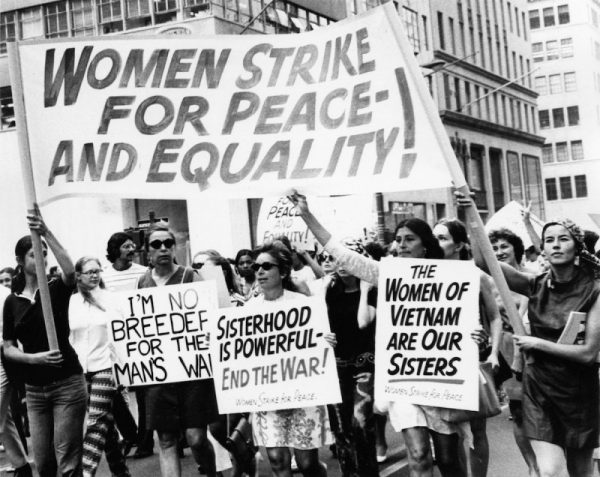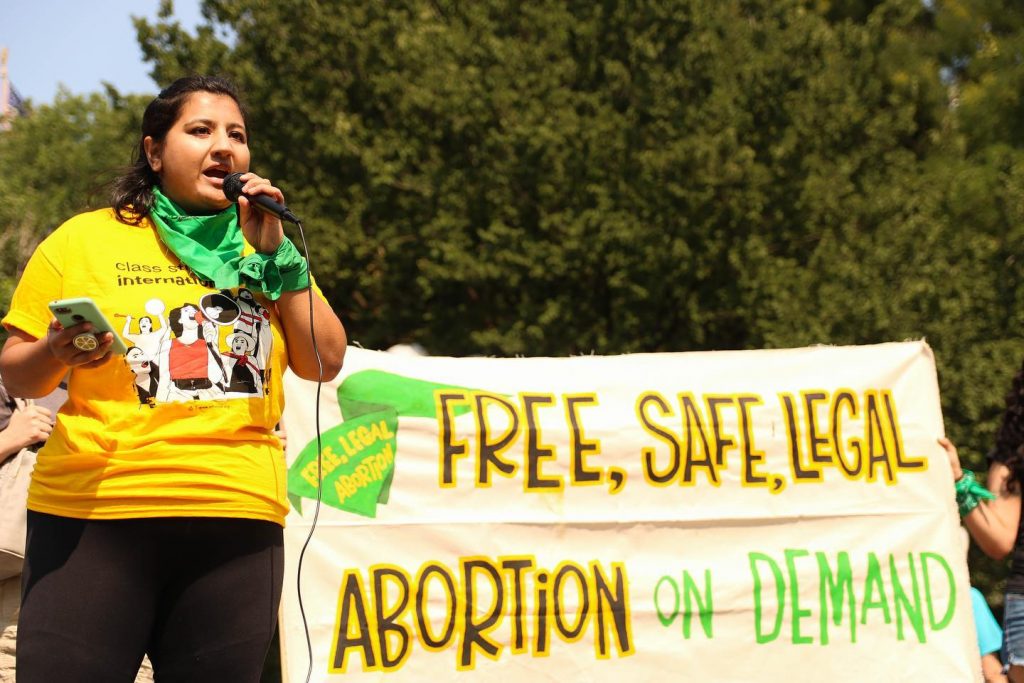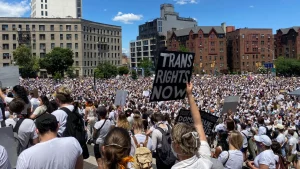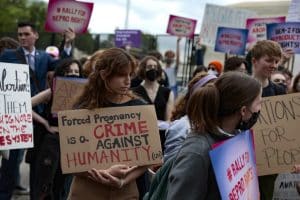On September 1, a draconian anti-abortion law went into effect in Texas. By now everyone knows the details: an abortion ban after 6 weeks of pregnancy, making 85 percent of abortions performed in Texas illegal. Lawsuits can be brought by anyone against anyone who has an abortion, or helps access or provide an abortion. And those who successfully sue can be awarded no less than $10,000 dollars in damages. This effectively puts a bounty on seeking, performing, or helping to acquire an abortion in Texas.
And the Supreme Court allowed this to pass.
This highlights the very real possibility that the Supreme Court will backtrack on Roe v Wade, ending the ability of people nationwide to access an abortion. In fact, starting on December 1, the Supreme Court will hear a Mississippi law that bars abortions after 15 weeks. While a few states have protections for abortions on the books at the state level, most states do not.
That’s why it’s urgent that we organize to take part in the national actions on October 2, taking the streets all over the country. In fact, we will not only fight to defend the right to an abortion — we will fight for free public abortions and free public healthcare.
We’ve Been Going Backwards for a While
While pro-choice protesters often use the refrain, “We won’t go back,” we’ve been going backwards for a while as abortion access has been eroded over the past decades. 24-hour waiting periods exist in 26 states. There are parental involvement laws for people under 18 in 38 states. Abortion clinics have closed all over the country — five states have just one abortion clinic. Many people are already forced to travel hundreds of miles to access abortion services, which means that the most precarious sectors of the working class that cannot afford to travel, find lodging, or take multiple days off of work do not have access to abortion.
For decades, a movement led by well-funded churches dubbing itself “pro-life” has organized against abortion rights. But this movement is actually misogynistic, anti-woman, and anti-queer. At every turn, it’s clear that “pro-life” is a cynical lie. Texas Governor Gregg Abott claims to be pro-life but presides over the state with the most death penalty murders in the country. He rescinded extended federal unemployment benefits early in an attempt to starve the working class back into unsafe workplaces in the midst of a pandemic. And in Texas, children froze to death due to a privatized and inadequate power grid.
Republican legislatures have been on the offensive against abortion rights for decades, while simultanously slashing budgets for healthcare, education, and other social services.
But it wasn’t just the Republicans who limited abortion access. The Hyde amendment, passed in 1977 under Democratic President Jimmy Carter, made abortion inaccessible for working class people. It forbids the use of Medicaid for abortion services and for many poor people, Medicaid is the only health insurance they have.
When signing the Hyde amendment, Carter said, “Well, as you know, there are many things in life that are not fair, that wealthy people can afford and poor people can’t. But I don’t believe that the Federal Government should take action to try to make these opportunities exactly equal, particularly when there is a moral factor involved.” So abortions became too expensive for the poorest people, especially those who had to travel long distances and take time off work.
The resistance to this — primarily focused on lawsuits and on electing Democrats — has been entirely ineffective. That’s why so much anti-abortion legislation has been able to pass already.
Looking Back to Move Forward
In one narrative of the fight for reproductive rights, the Supreme Court had a change of heart, or a change in interpretation of the constitution, and granted people the right to an abortion. According to this narrative, the Court holds the power for change and what matters is the politics of its justices.
But that’s not what happened at all.
It’s just not true that abortion was won by benevolent or progressive Supreme Court justices. The Supreme Court is an anti-democratic institution where nine unelected people get to be appointed and make decisions for life from on-high. When they have made progressive decisions, it’s not due to the law or even their own politics — it’s because of the movement that forced the Court’s hand. The only reason the court decided in favor of Roe, and the right to an abortion in most cases, was because there was a movement in the streets. This included mass marches and speakouts in the context of Vietnam war protests, the aftermath of the Stonewall uprising, and the Black Power movement.

Eugene Gordon—The New York Historical Society / Getty Images
The feminist movement of the 1970s sought to break down the stigma around abortions by framing them as a right and as a part of healthcare. The most left elements of the movement combined this demand with others, including childcare under community control and an end to the forced sterilizations of women of color, as a 1970 march of 40,000 people in New York City did. The movement had many limits, including seperatist sectors of the movement that did not see the need to struggle alongside men against racism and capitalism. But the early feminist movement also had a lot we can learn from. The International Women’s Day March included demands like “An end to job slavery: Equal and full employment; thirty-hour work week; and worker control of profits” and “Life-long health care supported by corporate taxes.” And it was this movement that forced the Roe v. Wade decision.
As Jenny Brown writes in Without Apology,
The court could not maintain its credibility as the arbiter of just law with women all over the country speaking out about their mistreatment in a massive, dangerous underground that maimed thousands of women yearly; with mass lawsuits threatening to invalidate state laws; with feminist groups providing illegal abortion referrals on every large college campus; with clergy openly and illegally referring women for abortions nationwide; with doctors openly performing abortions; and with feminists marching to overthrow the male supremacist order. In 1973, the court legalized most abortions to maintain its own legitimacy.
Winning reproductive rights wasn’t about “good” justices or about finding the right legal argument. A radical movement for abortion without apology, as well as for jobs, childcare and more, in a context of broad social upheaval, forced the Supreme Court to legalize abortion.
But since Roe, the movement has slowly but surely abandoned the streets as well as the unapologetic approach to abortion — and the radical demands for childcare and jobs that went alongside it. After Roe v. Wade, what was once a radical movement for change became part of the institutionalization of the social movements in the neoliberal era. The fight for abortion rights became organized in non-profits that rely on money from wealthy funders. Their political strategy was lawsuits, and canvassing for and appealing to the Democratic Party.
Gone were the days of talking about abortion on demand and without apology. Gone were the days of demanding free abortions. After all, if the strategy is not to build a mass movement, but rather to appeal to the courts and big money donors, perhaps “free childcare under community control” and “free abortion on demand” is not the slogan to call for. This was replaced by a faux discussion of “choice” within the confines of capitalism: is it really a choice if low income people can’t access abortion? Is it a choice without parental leave or free childcare? Without housing and healthcare? Abortion rights became subsumed by a neoliberal notion of individual choice and personal responsibility within the confines of an oppressive system that gives low-income people and people of color almost no choices at all.
This has been a losing strategy, not just for a more ambitious feminist agenda, but for the right to abortion itself.
The Graveyard of Social Movements
Alongside the strategy of lawsuits has been the strategy of supporting and canvassing for Democrats as a way to defend abortion rights. This has consistently shown itself to be a dead end. After all, Democrats, too, stand in the way of abortion rights. They have not passed abortion legislation at the federal level since the legalization of abortion in 1973, have actually limited it with measures like the Hyde amendment.
In fact, Joe Biden supported the Hyde amendment until his 2020 bid for the Presidency, when that position became untenable. Joe Manchin, a Democrat, recently said he would tank the reconciliation bill if it included a repeal of the Hyde amendment. And yet, Planned Parenthood spent a record $45 million on the 2020 elections to elect Democrats and Joe Biden.
Even active movements in the streets have ended up as part of an electoral strategy for the Democrats. Just four years ago, when the Women’s March brought millions of people into the streets against Donald Trump, it looked like there was room for a new wave of feminist organizing that could revive the movement to protect abortion rights. Of course, the limits of ideology of the March organizers and many marchers was clear from the start — these marches wouldn’t have occurred under a Hillary Clinton Presidency, even though Clinton’s “lean in feminism” promises nothing but continued exploitation and oppression for working class people the world over. While the march was not radical in slogans or tactics and had a real dearth of mobilized communities of color, it signaled a turning point and opened the possibility of a more active feminist movement. The International Women’s Strike brought out thousands with an anti-capitalist message that same year. All over the world, mass actions under the slogan of a “Women’s Strike” took place. In some countries, such as Italy, some labor unions were even forced to call a day-long strike.
By 2018, however, the organizers of the Women’s March explicitly made the action into a wing of the Democratic Party. The march’s main slogan was “Power to the Polls.” In other words, it reduced the power of millions of people in the street to a mere campaign rally for the Democratic Party — a Democratic Party that passed and maintains the Hyde amendment, not to mention the imperialist, racist and anti-worker policies that disproportionately affect women of color at home and abroad. The march organizers were sending a clear message to a new generation of protesters: taking the streets is okay, but our power is at the polls. Further, it sent the message that the problem was Trump and the Republicans — once the Democrats were in office, everything would be safe.
Indeed, the Democrats got what they wanted out of the Women’s March. In part because of a wave of women voters, the Democrats had a very successful midterm election. The year after, amidst infighting and accusations of anti-Semitism and poor organizing, the Women’s March dwindled in size. Nevertheless, the March continues to maintain massive reach, as highlighted by the organizers’ ability to call for a nation-wide day of action on October 2.
But even now, the Women’s March is not putting the full weight of its funding and organizing behind building a successful action on October 2. While it is good that the Women’s March is calling for national actions, in cities like New York they have opted for several small protests instead of organizing one large demonstration. They aren’t even using their platform to mobilize celebrities to come to their march, much less non-profits and unions. Rather than using their money and platform to really advertise what is at stake and move millions to the streets, these are the paid ads showing up:

This is not the approach to building a mass movement for abortion rights. This doesn’t capture or even try to capture the spirit of urgency of this moment.
The Women’s March is leading the movement to marches that are much smaller than they could be if the group organized to mobilize as many people as possible. And after these marches, the Democrats will use abortion rights as a way to mobilize people to the polls at the midterms and people will trust them, believing there is no alternative.
We can’t let the movement become an electoral pawn for the Democrats like the Women’s Marches of the past. That is where movements go to die, and that is why we have been going backwards for decades. That’s why we need an independent movement for abortion rights and reproductive justice.
Take the Streets, Build a Movement
But it’s time to change this ineffective resistance and put up a real fight. We need a mass movement, like the one in Argentina that legalized abortion after hundreds of thousands mobilized in the streets, and like the one in Ireland. Both of these are predominantly Catholic countries that forced the legalization of abortion.
We need a mass movement like the one that emerged in the 1970s and forced the hand of the Supreme Court. In its most left moments, this movement connected the struggle for abortion rights to the struggle for racial justice, childcare, and jobs.
This means taking the streets on October 2. It means going all out — bringing friends, co-workers, and neighbors. It means calling on our unions to mobilize and organize workplace actions, as well as non-profits and socialist organizations. After all, access to abortion is a class issue: when barriers exist to abortion access, it is poor people and people of color who will be forced into unsafe procedures.
It means an all-out defense of the doctor who bravely spoke out about breaking the draconian Texas law. It means that healthcare unions and Planned Parenthood should immediately make a fund to defend all healthcare workers who break the Texas law, stating clearly that we will not respect this law that violates the basic rights of people who can get pregnant.
This is the kind of disruptive mass movement we need: one that says that we won’t respect these anti-choice laws and sees that the solution is in the streets and in our workplaces, not in the Supreme Court or the Democratic Party. We know that they can’t and won’t stop this onslaught — it’s up to us.
Free Abortion, Free Healthcare
A mass movement must fight for more than just defending Roe v. Wade, a case which hinges on the right to privacy, as if abortions were something to hide away and be ashamed of. We want abortions to be a part of the right to bodily autonomy. We want abortion because abortion is healthcare, and healthcare is a right.
But the truth is that healthcare isn’t a right in the United States. Rather, it’s a commodity for insurance companies, big pharma, and hospitals to profit from. And in the meantime, healthcare workers are worked to the bone in unsafe, overcrowded hospitals, and patients experience subpar care for which they pay exorbitant prices.
The fact that abortions are healthcare, and healthcare is a right means that we have the right to free, public healthcare — not in the hands of the same politicians who are trying to take away our right to an abortion, or who ended the eviction moratorium to put families in the streets. We need free, public healthcare under control of the workers and patients who are directly affected by decisions made about healthcare. As nurse practitioner Angelique Saavedra argues,
As a nurse practitioner who provides Medical (or drug induced) abortions to pregnant people in New York, I believe that abortion is an important health care service. Not only should it be legal, it should be free and accessible for anyone who needs it. It is an essential part of the fight for Medicare for All and ultimately nationalized healthcare under worker control. It’s folks like me and my co-workers, and the patients we serve, many of them essential workers themselves, who should be making decisions about healthcare, not politicians.
The Fight for a Real Choice Is the Fight for Socialism
But our struggle isn’t just for the right to an abortion — it’s also for the right to be parents when and if people want to. It means fighting against the racist notions of the “welfare queen” and blaming poverty on the reproductive choices of women of color rather than on low wages and lack of government services. This means a struggle against the forced sterilizations of people of color that have occurred throughout U.S. history and still occur today. One third of the women in Puerto Rico were sterilized from 1930 to the 1980s. Today, those sterilizations occur in ICE detention centers.
A real choice means fighting for conditions for people to have children if they want, including federally mandated parental leave, which the U.S. does not have. It means free, safe, and enriching childcare; free, public education, and university; and free, quality housing for everyone. It means a real living wage that allows us to live and thrive.
Within capitalism “choice” is a cynical joke; all too often it means minimal choices among a variety of bad choices. How can there be real choice in a system that divides families by borders? Or in a system that divides families by racist prison system?
That’s why we fight for a society of real choices, not constrained by the misery created by a society structured for capitalist profits.
This October 2, take the streets to defend abortion rights. But it’s just the first step. We must build a much bigger movement that fights the very structure of a society that puts profits over people.











